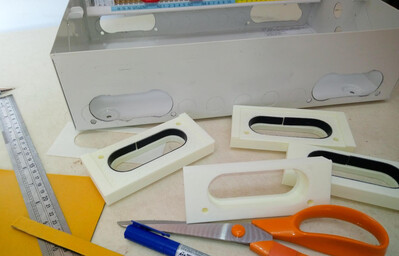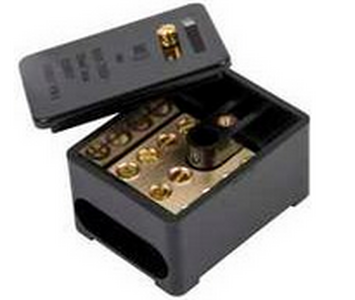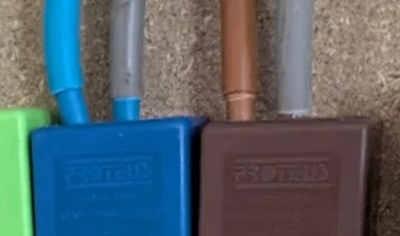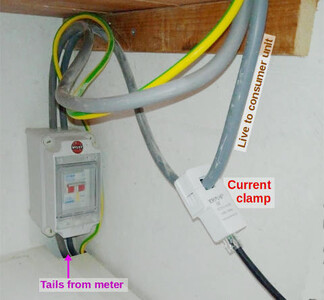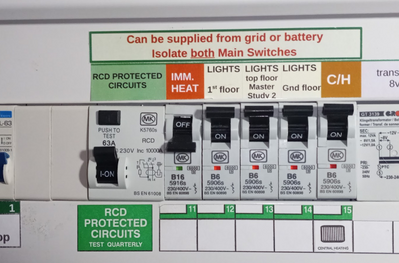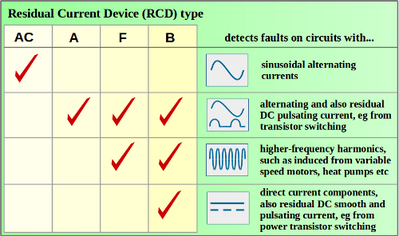Can I add an EV charger to a full consumer unit by coupling with a garage DB?
We’re thinking of getting an electric vehicle (possibly later this year), but we’ve hit a potential snag: our consumer unit is full, and there are no spare slots for an EV charger. However, we do have a garage distribution board (DB) that connects to the consumer unit, and our solar PV array is already feeding into the house through this setup.
My question is: Can we couple the EV charger with the garage DB to avoid overloading the consumer unit? Or can the EV charger just be added to the garage DB?
Has anyone done something similar, or could anyone (probably @transparent) advise on whether this is a viable solution?
Get a copy of The Ultimate Guide to Heat Pumps
Subscribe and follow our YouTube channel!
It might be technically possible to run an EV charger from a distant secondary Consumer Unit, but it's bad practice.
There will be considerable voltage-drop along the cable between the two Units.
The EV charger is likely to be the device which draws the highest current, and will ideally have an MCB rated at 32A or above, and its own Type-B RCCD.
When you look at DBs you'll notice that electricians arrange the circuits with the high-current trips closest to the Main Switch,
and the low-power lighting circuits further away.
So you want the connection point for that EV charger as close as you can to the Main Switch, not hanging off a sub-box in the garage with a bit of string between them!
Although I could've shuffled my circuits around, I've got a separate steel Consumer Unit below the existing one. That houses the RCCD and MCB for the EV charge point.
There's a couple of 10mm² wires which connect the EV trips directly back to the output of the Main Switch above.
Connecting together multiple consumer units is permissible, provided that there are metal bolts holding them together,
and all cables between them pass through insulated 'shields' to prevent them being touched.
Consumer Unit manufacturers offer 'joining kits' which include the brass bolts, thick wires and an insulated shield.
The insulated shields available for my MK Sentry enclosures weren't quite what I wanted because the wall behind wasn't completely flat.
So I made my own with a 3D printer, incorporating a 10mm-wide groove.
Before connecting the enclosures together, that groove is filled with intumescent strip.
If there's a fire in one consumer unit, the strip rapidly expands with the heat, completely filling the cable-passage with 'foam'.
That prevents flame and smoke from passing between the consumer units.
Save energy... recycle electrons!
We have two car chargers with different plugs🙄 - a 32A one and a 10A one. The larger one is fed with 6mm2 cable from its own tiny CU (looks just like the pic that Transparent posted) which is fed from the main tails using henley blocks. Don’t know why the sparky used Henley’s rather than coming from main CU, there was room.
The smaller one is just a leaf granny cable that came with the car, plugs into a socket. We used to have a ‘proper charger’ for it, and had intended to sell the leaf by now… but Mrs Robl doesn’t like driving the tesla so much these days 🤪
I expect whether you can add to a garage CU depends on its fuse rating and diversity (is there a home battery charging at night too?) and what your sparky thinks.
Posted by: @roblwhether you can add to a garage CU depends on its fuse rating and diversity
That's absolutely the case.
I haven't (yet) suggested that @editor tells us the cable size/type and distance between the main house CU and the one in the garage.
If it were substantial, it may indeed offer a route to run an EV charger off the garage unit.
There are formulae for calculating this, which also take into account the ability of that inter-connecting cable to dissipate heat.
Here on the forum I tend to first suggest a strategy which demonstrates best practice,
rather than what might 'just about be acceptable' for a particular site.
Yes we have the Wiring Regulations, and the quality of work by the majority of British electricians is very high.
But if we can do better than the basic regulatory requirements, then I think we should do so!
Posted by: @roblThe larger one is fed with 6mm2 cable from its own tiny CU [....] which is fed from the main tails using henley blocks. Don’t know why the sparky used Henley’s rather than coming from main CU, there was room.
So we all know - this is a Henley block
It allows three or more cables to be connected together outside of a consumer unit.
Most are black, but Proteus offer colour-coded Henleys.
They are too often fitted incorrectly.
Typical mistakes are:
- Henley block itself not firmly screwed to the backboard
- copper conductor gripped by only one of the internal bolts
- the brass bolts not sufficiently tight (creates heat)
- the lid-screw not 'sealed' with a wire loop in circumstances when it should be (when it's used with meter tails for example)
- the outer insulation of a meter-tail cut back short, which exposes the inner insulation layer
Issues arise when it's unclear if the Switch Disconnector in the main Consumer Unit will or won't remove power from adjacent Henley Blocks.
I'd need to see a photo of Rob's installation to comment further.
Save energy... recycle electrons!
Have you considered making space in your consumer unit by using RCBO's instead of RCDs and MCBs?
House-2 bed partial stone bungalow, 5kW Samsung Gen 6 ASHP (Self install)
6.9 kWp of PV
5kWh DC coupled battery
Blog: https://thegreeningofrosecottage.weebly.com/
Heatpump Stats: http://heatpumpmonitor.org/system/view?id=60
Since I had dug a trench for the heat pump only for Octopus to say it had sent the wrong diagram, I decided to get Octopus to fix me a Zappi for my EV. I had previously had the House CU replaced with 5 spare slots for these works and was surprised that the Installer brought a small Proteus CU. He said they always fit their own to avoid responsibility for subsequent faults in the existing house one. Any alterations to a CU renders the electrician responsible for the whole installation. He also found the Smets 2 smart meter the other installer fitted had 16 mm tails not 25 mm , he sorted this out while tidying the board. Next the ASHP people will fit two more CU's!! The unusual thing I was taught about electrics is that in the event of a serious accident you are guilty until you prove your innocence!!
Daikin 6Kw ASHP.
MG4 EV
1926 Semi with loft and wall cavity insulation, all radiator.
Posted by: @jancoldHe also found the Smets 2 smart meter the other installer fitted had 16 mm tails not 25 mm
It's quite possible that the incomer to your house is (still) 16mm² of course.
When we had appliances which only switched on periodically, that was regarded as acceptable, and was often connected to a 100A service fuse.
But we now have devices which draw high current for extensive periods of time, and you'd expect 25mm² wire to be the norm.
Fitting a separate CU for the EV trips is ok, provided it's clear whether or not this is energised using the Switch Disconnector on the main CU.
An electrician might decide to use separate Switch Disconnectors, or possibly rely on an isolator on the tails between the meter and the two CUs.
I think it best to label everything whilst it's still fresh in your mind.
Save energy... recycle electrons!
Posted by: @bontwoodyHave you considered making space in your consumer unit by using RCBO's instead of RCDs and MCBs?
That depends on whether your EV charger requires Type-A or Type-B RCD protection.
There are no RCBOs with Type-B (DC fault detection).
Type-B RCDs are obviously 'better', but fearfully expensive.
When I bought my Chint NL210-63-463/30 RCD, the list price was above £250 +VAT.
As it's a safety device, the manufacturer and where you get it from matters.
I can import a Chint RCD type-B from the Far East for £50, but the only thing 'Chint' about it is the printing on the front.
I wouldn't trust it to save my life in the event of a fault. 🤔
Save energy... recycle electrons!
@transparent I had two RCDs in my consumer unit and have just taken out one and replaced the MCBs it was supplying with RCBOs. That created two empty slots. I suppose you could keep the car charger on the remaining RCD and just move some other circuits to the RCBOs
House-2 bed partial stone bungalow, 5kW Samsung Gen 6 ASHP (Self install)
6.9 kWp of PV
5kWh DC coupled battery
Blog: https://thegreeningofrosecottage.weebly.com/
Heatpump Stats: http://heatpumpmonitor.org/system/view?id=60
Yes @bontwoody
but it depends what that RCD is.
If it's just a standard AC-rated unit, then it's unlikely to be suitable for an EV charger.
They're renowned for imposing DC leakage currents.
Save energy... recycle electrons!
As I understand it, if a slowly rising common mode DC is passed through the AC only type of RCDs then it will saturate the core in it, and then it can’t detect any signals. This means that not only will that dc not trip it, but not will any subsequent ac fault current. This is especially critical for some fuse boxes which have one RCD covering many MCBs - if any of them have a small dc offset, then none of the circuits will have RCD based protection. I’m not sure which electronics is most likely to impose dc fault currents though - why are car chargers worse than high power computer power supplies, which have similar high power switch mode systems. In contrast resistive loads and old fashioned 50Hz transformers won’t have this dc fault current.
"But we now have devices which draw high current for extensive periods of time, and you'd expect 25mm² wire to be the norm."
Agreed and my understanding when I changed my CU many years ago was that nothing less than 25 mm tails were acceptable then, let alone now, and the DNO cable supply size was up to them, not for us to even know about. Maybe the meter replacement installer knew that as he had arrived with the isolating switch and meter pre-wired to connect to the cut out fused at 100A. I really think we deserve to know more about how our electric supply works and is connected thank you @transparent .
Daikin 6Kw ASHP.
MG4 EV
1926 Semi with loft and wall cavity insulation, all radiator.
- 26 Forums
- 2,372 Topics
- 53.8 K Posts
- 477 Online
- 6,053 Members
Join Us!
Worth Watching
Latest Posts
-
RE: Testing new controls/monitoring for Midea Clone ASHP
Seems to be the only logical explanation. Our ASHP was ...
By benson , 38 minutes ago
-
RE: Solar Power Output – Let’s Compare Generation Figures
@toodles I sail, so have a feel for what wind can do. A...
By Papahuhu , 41 minutes ago
-
RE: Radiator sizing sanity check
@jamespa thanks, yes it seemed mad to me. An exert f...
By Papahuhu , 1 hour ago
-
RE: Optimum new build house design for Heat Pump
From first principles I would say: Definitel...
By JamesPa , 2 hours ago
-
RE: Cascade 2x Grant Areona 10kw ASHP - Ongoing setup issues
This is actually normal, or at least its more or less w...
By JamesPa , 3 hours ago
-

RE: Weather compensation- why you should use it
As good a place as any to drop this video:/p>
By Mars , 6 hours ago
-
RE: Forum updates, announcements & issues
@transparent D'Oh - I did look before I posted but I mi...
By dr_dongle , 7 hours ago
-
Compatibility with Samsung AE080RXYDEH
I am new to all this. We have a SamsungAE080RXYDEH that...
By John999 , 7 hours ago
-
RE: New Fogstar 15.5kWh upright solution
@batpred Maybe you should buy your additional batter...
By Bash , 9 hours ago
-

RE: Data Accuracy Problem: Daikin 8kW Heat Pump's Onecta App vs MMI Power Consumption
@nursethescreens Yes, comfort and happiness of the fami...
By Toodles , 9 hours ago
-
RE: Connecting Growatt SPH5000 over wired ethernet rather than wireless
Thanks folks. I had tried googling an ethernet lab adap...
By z8lccda , 24 hours ago
-
RE: Changing from 4-port buffer to volumizer
@toodles I'm not concerned that the behaviour is not no...
By Andy1618 , 1 day ago
-

-

RE: Setback savings - fact or fiction?
I agree, and I think there are two things in play here....
By cathodeRay , 1 day ago
-
RE: Water Hammer After Heat Pump Install
That's really helpful. Yor last sentence confirms it'...
By JamesPa , 1 day ago
-
RE: Help needed with Grant Aerona 3 issues
First time posting so bear with me. Some bits that have...
By Adamp , 2 days ago
-
RE: Mitsu PUHZ-SW120YHA + EHSC-VM20Uk - Performance
All understood. Obviously its a bit house de...
By JamesPa , 2 days ago
-
RE: Who's your electricity provider and what's your tariff?
@majordennisbloodnok This may be a better thread to ...
By Batpred , 3 days ago
-

RE: Best Heat Pump Brand in the UK
Last Call to Vote & Win! Haven't voted for your Hea...
By Mars , 3 days ago




